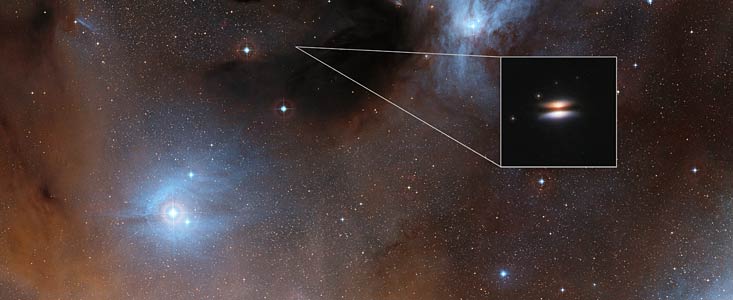
Grains of dust in the protoplanetary disc will go on to form new planets, but this body is colder than current models would lead astronomers to expect.
Astronomers are unsure what to make of a newly discovered flying saucer structure circling a distant star. The protoplanetary disc is circling a young star known as 2MASS J16281370-2431391, found within the Rho Ophiuchi star-forming region roughly 400 light-years from Earth’s solar system. As seen from Earth, the disd resembles a typical representation of a flying saucer.
The particularly unusual thing about this disc is that it is cold. So cold that it doesn’t meet current planetary formation models. It appears as a glowing halo with a dark band in the middle. It is the dark band that leads to the surprise.
Stephane Guilloteau, lead astronomer in the study, who is from the Laboratoire d’Astrophysique de Bordeaux in France, says that the disc is seen in silhouette in front of the glow of the Rho Ophiuchi Nebrula. The disc absorbs the diffuse glow of the nebula, resulting in a negative signal that means that parts of the disc are colder than the background. “The Earth is quite literally in the shadow of the Flying Saucer!”
Another anomaly is that planetary discs typically form at various angles with respect to the sun. However, this body appears edge-on from Earth, which has earned it the nickname Flying Saucer.
Guilloteau’s team measured the grains of dust in the Flying Saucer, which are approximately one millimeter across, and found that they have a low temperature of 7 degrees above absolute zero, -266 degrees Celsius. As the system matures the grains will eventually go on to form planets, but current models indicate that the dust should be warmer – at least 10 to 15 degrees above absolute zero. In the field of planetary formation the temperature difference is huge.
Dust temperature in protoplanetary discs can have a great impact on the size and developmental characteristics of new planets. Cooler dust can lead to larger planets closer to the parent star.
More studies of protoplanetary discs are needed to determine whether the newly discovered temperature versus particle size trend is typical in planet-forming systems.

Leave a Reply